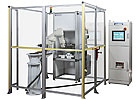
Traditional vibratory bowl feeders use a helical shelf-like inclined ramp winding up from the bottom of a bowl to a discharge passageway. The passageway’s reciprocating motion pushes the parts up the ramp. Obstructions, cutouts and other orienting devices are arranged along the passageway to topple off parts that are incorrectly oriented and allow through only those parts that are positioned correctly.
Historically, because of the various hard-tooled orientation features that are required, this kind of equipment has been very part-specific. However, the robotics company Rixan Associates Inc. has developed a new flexible vibratory bowl feeder that includes a robot and machine vision system to orient multiple parts using a single system.
Rixan originally developed the system to load dozens of different aerospace fasteners into a press, a task that was previously performed by hand and would have otherwise required installing many different feeders to automate.
The new system employs a vibratory bowl feeder that randomly presents the parts to the vision system, which in turn, stops the feeder when it sees the correct part in the correct orientation so that a robot can load the part into the press. The parts are presented on a semitransparent, backlit plenum, so the vision system can easily identify them. The parts that are not picked automatically recycle into the bowl. The result has been a 20 percent increase in productivity and one less operator to tend the press.
Critical to the success of the system has been its In-Sight 5401 vision system from machine vision manufacturer Cognex Corp., which is integrated with an RV-6SL-S11 robot and Melfa-Vision software from Mitsubishi Electric. Rixan chose the In-Sight 5401 because of its processing power and the fact that it can acquire up to 60 complete eight-bit images per second.
To develop the application, Rixan engineers first used the Melfa-Vision software to calibrate the robot in relation to the feeder. They then put a part in the robot gripper and “jogged” the robot over to the feeder where it set the part down on the plenum. In this way engineers “taught” the robot to pick up the part in this orientation and at this point on the plenum.
Once the robot had been taught how to pick up the part, Rixan’s engineers used the Cognex camera’s PatFind object-location tool to draw a rectangle around the part on the screen, thereby allowing the vision system to automatically recognize the part as it moves across the plenum.
In operation, when it sees a part, the system first sends a signal to stop the feeder. After the feeder has stopped, the vision system acquires one last image to determine the exact position of the part and calculate its angle of presentation. The robot then moves to the location of the part, twists its wrist to match the part’s orientation, picks up the part and sends a signal to restart the feeder.
Most of the parts in the aerospace fastener application are symmetrical top to bottom so they can be identified from their silhouette alone. However, in those instances where a part has two distinct sides, the Cognex PatMax tool can be used to recognize which side is up. Top-down lighting is used for parts in which pattern recognition is required. White light is used for some parts, while glare-free polarized lighting is used for others.
“A key to the success of this application is the ease-of-setup, accuracy and reliability of the Cognex In-Sight vision sensors,” says Rixan Associates President Stephen Harris. “The PatMax tool that we use to recognize part features is much faster and more accurate than other comparable industry tools that we have seen. The easy integration between Cognex vision sensors and Mitsubishi robots drastically reduces the amount of time required to develop vision-enabled robot applications and in most cases eliminates the need for writing a single line of code.”
For more on machine vision, call 508-650-3000 or visitwww.cognex.com.
For more on parts feeding and automation, call 937-438-3005 or visitwww.rixan.com.